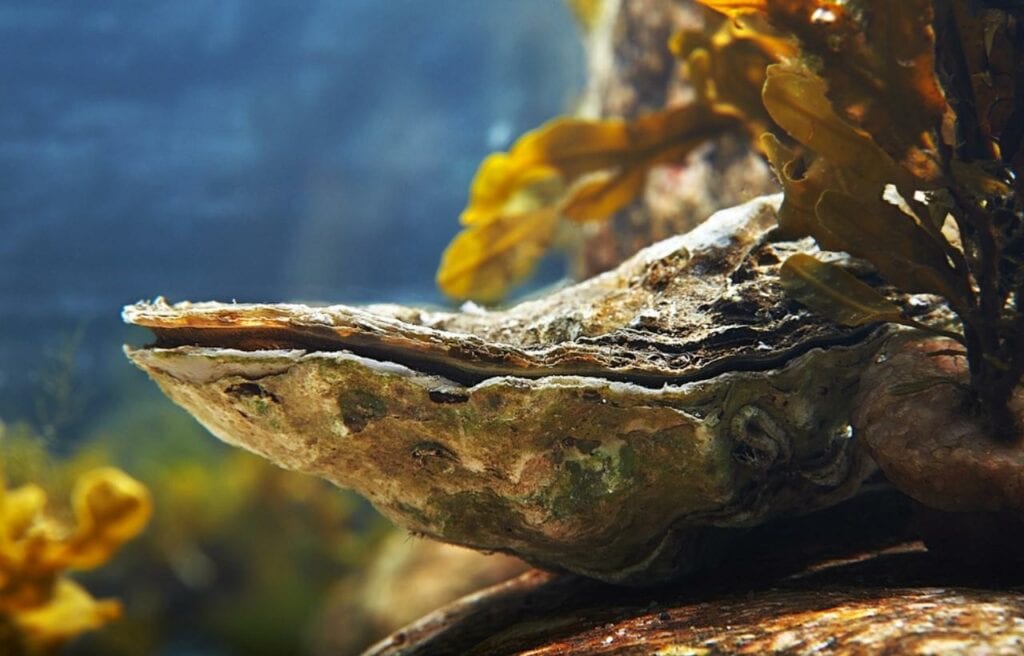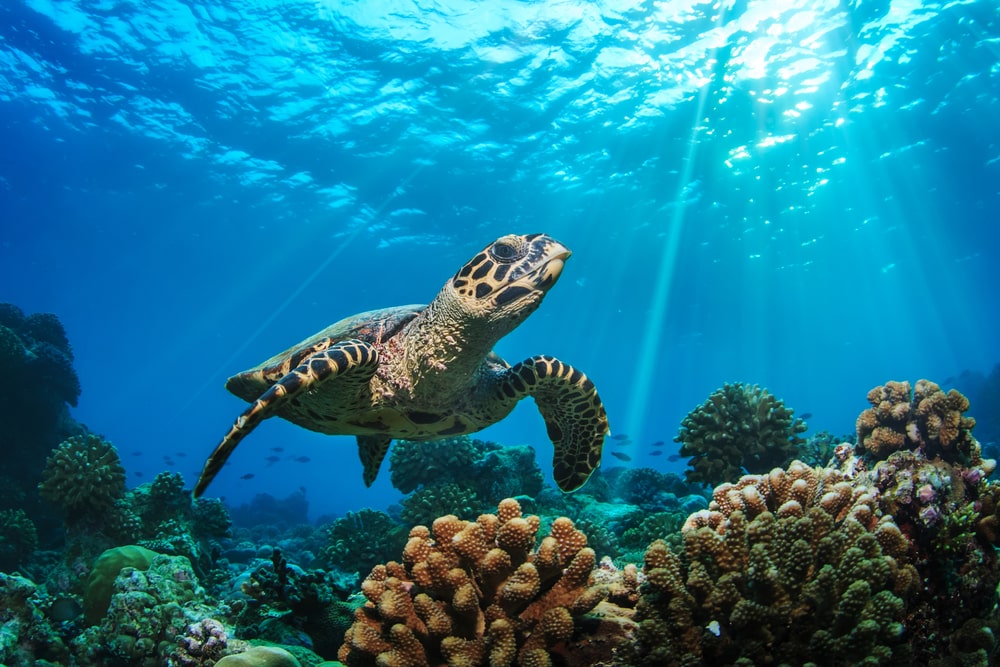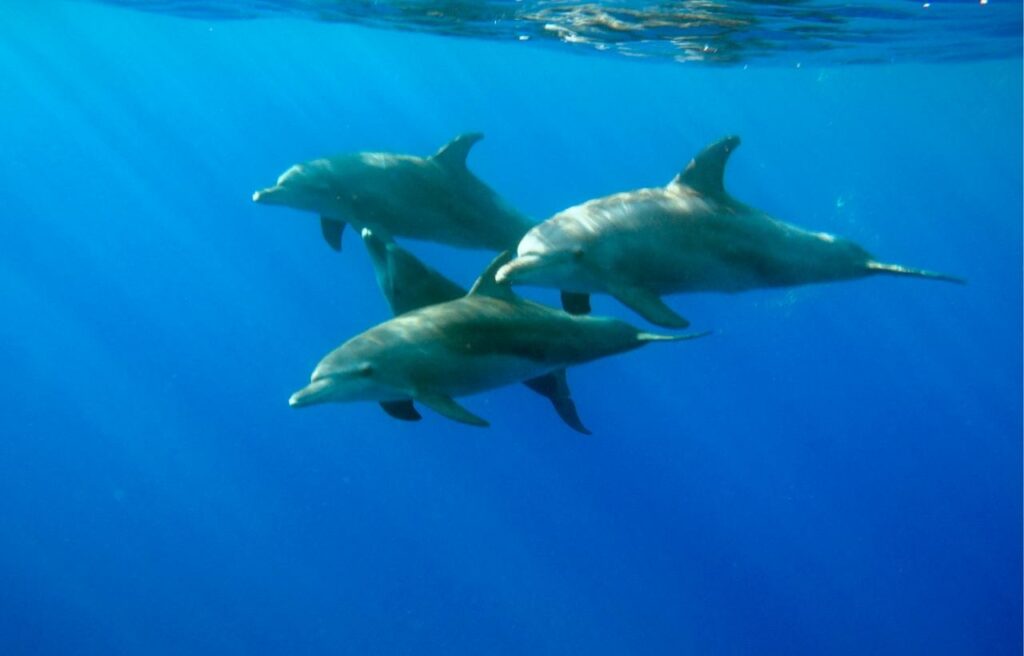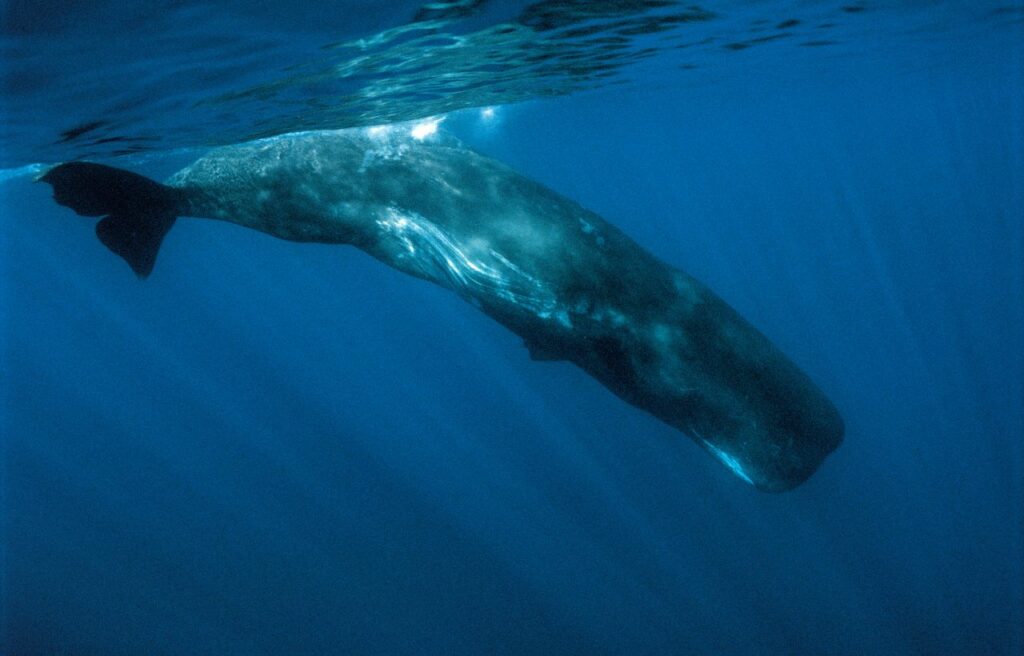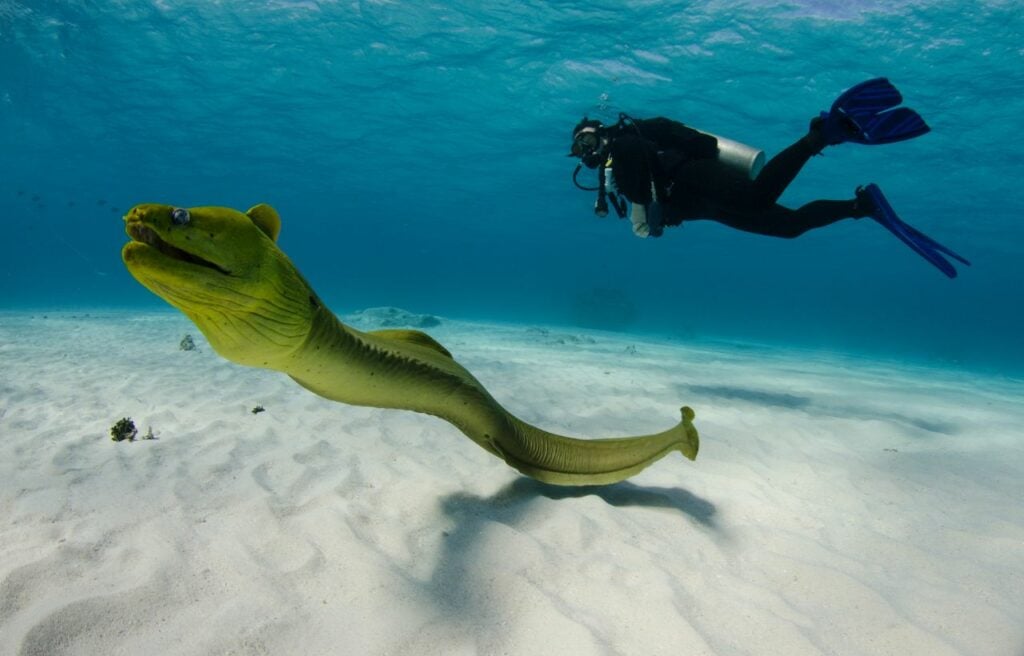Outforia Quicktake: Key Takeaways
- Octopuses are highly intelligent and can change the color and texture of their skin for camouflage.
- Coral reefs are crucial ecosystems, supporting 25% of ocean organisms, but are threatened by rising ocean temperatures.
- Sea turtles are endangered due to climate change, habitat loss, and human actions.
- Sharks are an ancient species with over 500 different types, playing a vital role in the ecosystem.
- Whales, including toothed and baleen whales, have complex communication through their distinctive “songs.”

The ocean is so vast that it wouldn’t be possible to cover every marine animal in a single article. But I can tell you about 14 of the most popular ocean animals worldwide.
Some of these animals live in the hearts of many, like sea otters, sea turtles, and dolphins. Others are scary but misunderstood like sharks and eels. Others are shrouded in mystery like the octopus and the eel.
Either way, you’ll find some kind of animal to interest you in this article. “Dive in” to learn more about our ocean’s wonderful creatures!
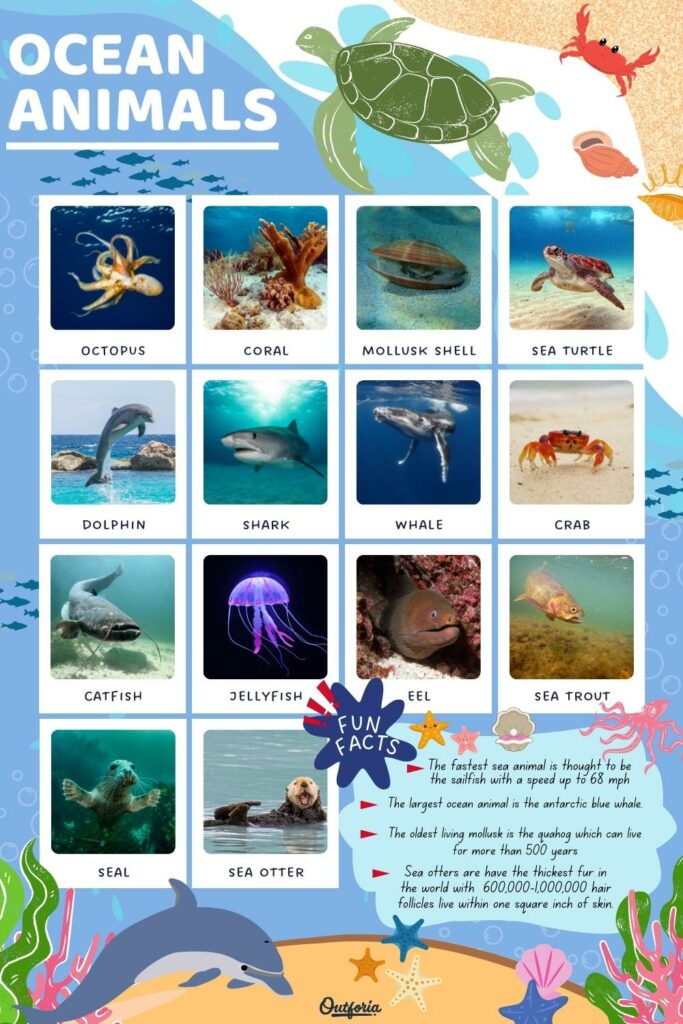
SHARE THIS IMAGE ON YOUR SITE
<a href="https://outforia.com/ocean-animals/"><img style="width:100%;" src="https://outforia.com/wp-content/uploads/2022/10/ocean-animals-infographic-683x1024.jpg"></a><br>OCEAN ANIMALS <a href="https://outforia.com">Outforia</a>Octopuses are highly intelligent creatures. Researchers say that they are the smartest invertebrates in the world. They are capable of problem-solving and can complete many different tasks. Octopuses can open jars, escape through tiny holes, and navigate mazes.
The downside is that octopuses live short lives. Depending on the species, an octopus’ lifespan is between half a year and up to five years.
What if they lived similar life spans to humans? We can only imagine how much more intelligent they could become.
Masters Of Camouflage
Most octopus species are also known for their impeccable camouflage skills. Most of these animals contain chromatophores. They are cells that allow the octopus to change the color and texture of its skin. This skill is invaluable when hiding from predators.
The Giant Pacific Octopus

There are over 300 types of octopus in the world.
The most notable octopus is the giant Pacific octopus. It is the largest species of octopus in the world and has the longest lifespan. Their arms can grow from 7-13ft (2-13m) long, and they can live for up to five years. Imagine meeting one of these animals during your swim!
You may also like: The Mysterious Mimic Octopus: The Master Of Disguise
There are at least 6,000 different kinds of corals around the world. Most grow in shallow, warm waters, but others live in the cold, dark depths of the deep ocean.
Coral reefs are small compared to the rest of the vast ocean. Still, we refer to them as the “rainforests of the sea.” This is because about 25% of the ocean’s organisms rely on coral reef systems.
Colonial Organisms
Corals are animals — a colonial organism, in fact. They consist of several different individuals. The individuals live together in harmony. Each organism is essential for the survival of the others.
The most notable organism living within a coral is the “zooxanthellae.” Zooxanthellae is a type of symbiotic algae. It removes waste from the coral and helps the coral photosynthesize. The zooxanthellae are also what give the coral its bright, beautiful colors.
Coral Bleaching

Unfortunately, with the rising ocean temperatures, the coral is dying off. This occurs in a process called “coral bleaching.” The corals become stressed by the high temperatures. This causes them to expel the zooxanthellae. This limits their access to food and leaves them more susceptible to disease.
Many people don’t think of shells as coming from a real animal. Most people don’t get to see the animal actually making use of shells. Rather, we find the empty remains of shells scattered across beaches.
There are at least 85,000 types of living mollusks in the world, likely more.
Still, shells are the protective cover of mollusks like clams, oysters, and snails. These animals have soft bodies that leave them unprotected. So, the shells are vital to their survival.
How the Shell Is Created
Mollusks have an outer layer of tissue on their body called a mantle. The mantle is what creates the shell and connects the animal to its shell. The shell develops with proteins and minerals that the animal secretes.
The Oldest & Largest Mollusks

The largest known mollusk is the giant clam (Tridacna gigas). It reaches up to 4ft (1.22m) in length and up to 500lbs (226.8kg). The oldest living mollusk is the quahog (Arctica islandica) which can live for more than 500 years. In fact, the quahog is the longest-lived species on Earth that we know of today.
You may also like: 15 Different Types Of Snails: Pictures, Chart & Facts
One of the most beloved sea creatures is the sea turtle, a large reptile covered in a hard carapace and scales. Like many ocean animals, sea turtles range greatly in size. There are seven different species.
The olive ridley is the smallest, usually under 100lbs (45.4kg). But the leatherback sea turtle can reach a staggering 650-1,300lbs (294.8-589.7kg).
Ancient Animals
Sea turtles are an ancient species. Researchers have found sea turtle fossils dating back 150 million years.
Back then, sea turtles traveled the world in staggering numbers. Today, sea turtles are endangered due to the actions of humans.
Sea Turtles Are Endangered
Climate change is a huge threat. The sex of baby sea turtles is determined by the climate. Warmer weather produces more females, while colder temperatures produce more males. With warming temperatures, about 90% of all offspring are female. If this trend continues, sea turtles may no longer be able to reproduce.
There are many other threats that rack them as well:
- Habitat loss
- Bycatch
- Oil spills
- Plastic ingestion
- Debris entanglement
- Artificial lighting
- Illegal harvesting
- Beach armoring
You may also like: Turtle Vs Tortoise: 7 Key Differences Detailed With Images And Facts
Dolphins are another one of the most popular ocean animals in the world. There are 32 species of known dolphins around the world.
Although they live in the ocean, they are mammals who breathe air. Plus, like all mammals, they give birth to live young.
Dolphins are incredibly intelligent animals with similar emotional capacities as humans. As such, their communication skills are highly developed. They communicate with each other through whistles, clicks, and squeals. They even use echolocation to determine where objects are throughout the water.
Orcas

Many people don’t know that the orca, or killer whale, is actually a type of dolphin. In fact, orcas are the largest species of dolphin in the world. The largest orcas can grow up to 32ft (9.8m) in length and weigh up to 22,046lbs (10,000kg).
You may also like: How Do Dolphins Sleep? With One Eye Open
Thanks to movies like Jaws, many people are fearful of sharks. In reality, sharks are rarely a danger to humans. Rather, they are incredibly important to the ecosystem.
Sharks are a type of fish with a wide range of sizes and patterns. Today, we know of about 500 different species of sharks.
The smallest sharks may only be 7 in (17.8cm) long and weigh less than an ounce (28.3g). The largest sharks can reach up to 32.8ft (10m) in length and a staggering 45,415lbs (20.6 tons)!
An Ancient Animal
Sharks are an incredibly old species, predating even the dinosaurs. Some fossilized teeth and scales date as far back as 400 million years.
Changing Teeth
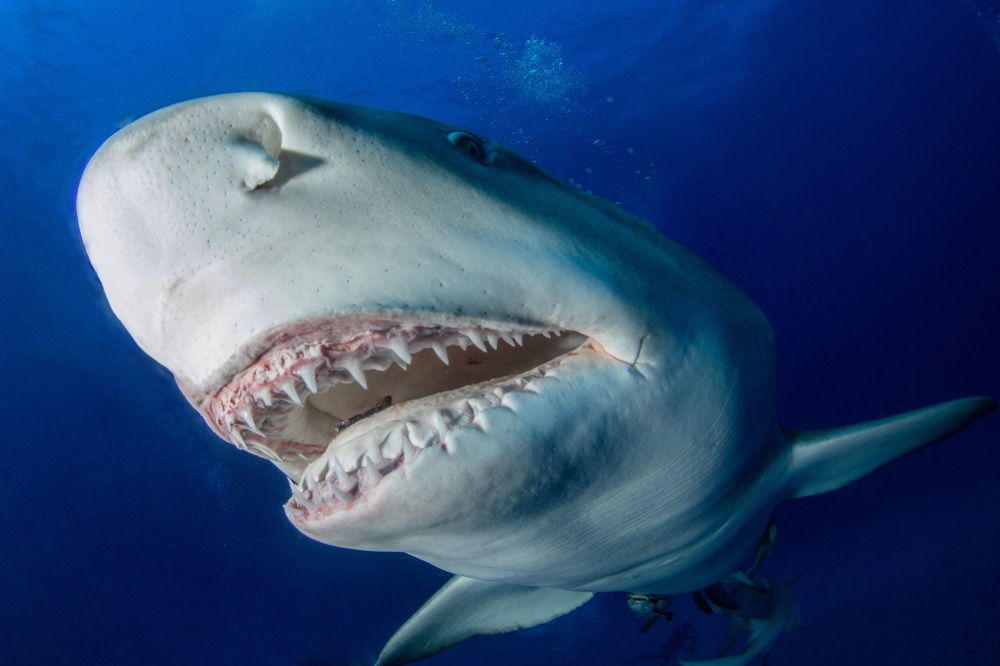
Speaking of teeth, sharks have many rows of individual teeth. They come in all sizes and shapes, depending on the species. Some species have serrated teeth that cut like a razor. Others have teeth that are more pointed to act like a spear.
Sharks continually lose and grow their teeth throughout their lifetime. This ensures that they can continue eating as they age despite the rough use of their mouths.
Misunderstood Animals
Although sharks scare many people, there’s not much reason to be frightened. Sharks do not actively hunt humans despite what the media tells us.
Attacks occur because a shark is curious, feels threatened, or mistakes a human for prey. In reality, people only have a one in 11.5 million chance of being attacked by a shark.
You may also like: How Do Sharks Mate? It Might Surprise You
Whales are another marine mammal that has a large degree of variation. There are about 40 different kinds of whales in the world.
The smallest kind of whale reaches just 9ft (2.7m) long and 500lbs (226.8kg). The largest whale species can reach up to 98ft (29.9m) long and up to 400,000lbs (200 tons)! The blue whale is the largest species of whale, and it is also the largest animal on the entire planet.
Toothed vs Baleen Whales
There are two different kinds of whales: toothed and baleen whales.
The toothed whales, of course, have teeth. They use these teeth for hunting and tearing into prey like fish, squid, and seals. Some toothed whales include dolphins, porpoises, sperm whales, and narwhals.
Baleen whales tend to be much larger than toothed whales. Baleen is a fingernail-like material that attaches to their upper jaws.
The strands of baleen act as a filter to strain water and prey. These whales like to feed on krill. They will suck large amounts of water into their mouth. The water is pushed back through the baleen, leaving only the krill behind.
Baleen whales include species like blue whales, humpback whales, right whales, and bowhead whales.
Whale Songs
One of the most beloved characteristics of whales is their calls. Their calls are a series of howls, cries, and moans called “whale songs.” These “songs” are so loud that you can hear them from thousands of miles away. When you hear a whale song, it is an otherworldly experience.
Deadly Communication?
This scenario hasn’t occurred yet. But, researchers theorize that the clicks of a sperm whale could kill a human.
A sperm whale can click at about 236 decibels, making it the loudest animal in the world. A human’s eardrums can burst at 150 decibels. Humans can die at 185-200 decibels of sound. The increased pressure can cause internal organs to rupture.
Researchers say that sperm whales intentionally quiet their calls around other creatures. If they didn’t, they could kill everything around them. Whales have been known to exhibit altruistic characteristics. So, this theory makes sense.
You may also like: How Do Whales Sleep? All About Their Surprising Ways To Slumber
Crabs, along with lobsters, shrimps, and barnacles, are arthropods. Arthropods are the largest group of animals, containing about 75% of all animals in the world.
Arthropods also include animals like insects and spiders. In total, there are about 6,000 different types of crabs in the world.
Chitinous Shells
Crabs are covered in a hard exoskeleton that consists of a protein called “chiton.” The shell is a supportive structure for the animal’s body and keeps them safe from predators.
Unlike mollusks, an arthropod’s shell does not grow with them. Instead, as their body grows, they must molt their shell before growing a new one.
Spider Crab

One of the most interesting kinds of crabs is the spider crab. Their bodies are small compared to their long, spindly legs. Their bodies only reach about 4in (10.16cm) across, while their legs can reach up to 12in (30.5cm) in length! I’m sure you can see where they get their name from.
Hermit Crabs & Fiddler Crabs

Two of the most popular types of crabs are hermit and fiddler crabs. You can keep both of these as pets. They make interesting little companions.
Hermit crabs are softer-bodied than other crabs. So, they use mollusk shells as protection. They will scavenge for discarded mollusk shells to use. They will then crawl into the shell and use it as their home. As they grow, they will discard the mollusk shell and look for a new one.
Fiddler crabs are entertaining to watch. They seem to dance about their habitat.
The males have one very large claw alongside a much smaller claw. The larger claw is basically useless other than to attract females. He will wave his large claw around in the air to try and attract any potential mates.
Catfish are a large group of fish that consists of about 3,000 species. They are known for their barbells.
The barbells are long and whisker-like, earning them the name “cat” fish. These fish mostly live in freshwater habitats. But they live in the ocean, too. They are so diverse that they live on every continent except Antarctica.
Another characteristic that makes catfish stand out is their body. They are smooth and do not have any scales. Their skin is either bare or covered in bony plates for protection.
Most catfish also have a hollow but bony leading ray on their dorsal and pectoral fin. Inside this ray is a stinging protein that the fish can use to defend itself. In some species, this protein is so strong that a human being can end up in the hospital.
Despite what their name suggests, jellyfish are not really fish. Instead, they are more closely related to sea anemones, corals, and hydrozoans. There are about 2,000 known species of jellyfish in the world.
Made Of Water
Jellyfish are complex animals considering most of their body consists of water. Over 95% of their total body mass consists of water. Still, their bodies are very simple compared to most of the animals we think of.
Their body consists of three layers: the epidermis, the middle layer, and the inner layer. The middle layer is thick and consists of a jelly-like substance called mesoglea.
They do not have blood, a brain, or even a heart. Yet, they have a nervous system called a “nerve net.” The nerve net allows them to smell, notice light, and respond to stimuli.
They Can Sting
Most people are fearful of jellyfish because their arms contain cnidocytes. Cnidocytes are stinging cells that the jellyfish uses to stun and capture its prey.
In some species, the sting is mild, only producing mild irritation to human skin. Other species are dangerous enough to land a human in the hospital. Still, they are rarely fatal.
You may also like: What Do Jellyfish Eat? Just About Anything They Can!
Eels are a type of fish that have long, snake-like bodies. Eels live all around the world in both freshwater and saltwater habitats.
Although they look like a completely different species, eels really are a type of fish! There are over 800 species of true eels in the order Anguilliformes.
But, there are “eels” that are not true eels at all. For example, electric eels are actually a type of knife fish. They are more closely related to catfish than they are to true eels.
Spawning Rituals
The life cycle of eels is quite complex and not well understood by researchers. Adult eels will migrate back to the open ocean to spawn and die shortly after. So, the juveniles begin their life in the open ocean in the larval phase.
Eventually, juvenile eels will go through a metamorphosis to reach their adult form. Many eels will leave the open ocean as they age. They will travel to freshwater or brackish water habitats.
Near the end of their lifecycle, they will travel back to the open ocean to spawn. So, an eel’s life begins and ends in the open ocean.
Researchers believe that all eels reproduce this way. This theory is largely accepted, but there is still much we don’t know about the lifecycle of eels. For the longest time, researchers were unable to see eels reproducing. So, their lifecycle was a complete mystery.
You may also like: How Do Electric Eels Work? All About The Fish That Will Shock You
Sea trout and brown trout are the same species (Salmo trutta). But, they are still different kinds of fish. When they are young, sea trout are silver in color.
After living in the river habitat for a while, the sea trout will lose its silvery color. It will look just like the brown trout, just bigger, making it difficult to tell the two apart.
Still, the animals are very diverse. Researchers have thought about dividing them into 50 different species.
Freshwater & Saltwater
Trout are anadromous. Which means they move between freshwater and saltwater. When they move depends on genetic and environmental factors. Most often, trout will move to sea when there is a lack of food in their freshwater habitat. They will swim to sea, eat, and then return to freshwater to spawn.
Unlike eels and salmon, most sea trout will not die after spawning.
Seals are marine mammals that live all around the world. Some prefer polar climates, while others live in temperate or tropical climates. In total, there are 33 types of seals around the world.
Seals are semi-aquatic, meaning they do not stay in the ocean forever. They love to come out of the water. You can often see them come to land to rest, sunbathe, molt their winter fur, and give birth.
As semi-aquatic animals, seals do not need to stay wet to survive. Sometimes, they will stay out of the water for several days.
Seals VS Sea Lions

Seals and sea lions are similar animals, so people often get confused. But, if you take the time to look, you’ll notice some key differences.
Seals do have ears, but they appear as a simple hole in the side of their head. Their front flippers have long claws covered with fur. Their back flippers point away from the body. Because of their rear flipper position, seals can’t rotate their bodies. Instead, they’ll scoot around on their body.
The ears are the easiest way to distinguish a sea lion from a seal. Unlike a seal, sea lions have ear flaps covering their ear holes. Their front flippers have long claws covered by skin but no fur.
Also, unlike seals, they can position their hind flippers underneath them. This allows them to rotate their bodies and walk on land.
Sea otters are another very popular semi-aquatic marine animal. People love watching them do flips in their pool at zoos and aquariums. They are active, charming little creatures who are very intelligent. Besides sea otters, there are 13 different kinds of otters worldwide.
Otters are members of the Mustelidae family. They are close relatives of other mammals like wolverines, badgers, skunks, and weasels. They are the largest member of the weasel family and the smallest marine mammal in North America.
They Have the Thickest Fur In the World
They also have the thickest fur of any other animal in the world. 600,000-1,000,000 hair follicles live within one square inch of skin. They don’t have blubber like other ocean animals, so the fur makes up for it.
They Are a Keystone Species
Sea otters are a keystone species, meaning they play a key role in the ecosystem. They are ravenous hunters of sea urchins, clams, mussels, and clams.
Without sea otters, sea urchins would take over. They would deplete the ecosystem of its kelp forests.
They Can Use Tools
Lastly, sea otters are brilliant animals. It’s rare for mammals to use tools, but otters do. Typically, they will use a rock like a hammer to break open the shells of their prey. They will even store their rock and any leftover food in a pocket of skin under their armpit.
Ocean Animals FAQs

What is the fastest sea animal?
The sailfish is thought to be the fastest animal in the ocean, topping out at speeds of up to 68mph (109.4km/h). They usually reach these speeds after leaping out of the water and diving back in to go after a school of fish.
What are ocean animals?
Simply put, ocean animals are animals that live in the sea. They include fish who use gills for breathing. They include mammals who have to surface for air. They include some of the most intelligent animals in the world. And they include some of the simplest animals in the world.
What is the biggest marine animal?
The Antarctic blue whale is the largest animal in the ocean and in the world. These animals are massive, reaching lengths of up to 98ft (29.9m) and weighing up to 400,000lbs (200 tons).
How does oil impact ocean life?
Oil spills are a preventable disaster that is devastating to all ocean life it touches. It destroys the insulation capabilities of animals with fur, like sea otters. It also ruins a sea bird’s feather’s water-repellent abilities. So, both animals with fur and feathers are likely to die of hypothermia.
What is the most common ocean animal?
Considering how much krill blue whales eat, it’s a good thing that they’re the most abundant animal in the ocean! In case you don’t know, krill are tiny, shrimp-like creatures.










